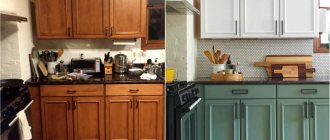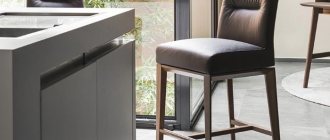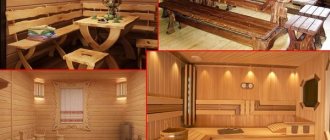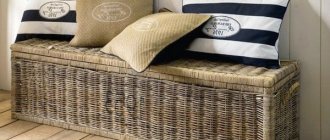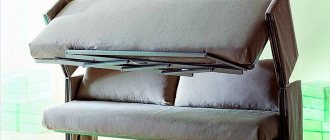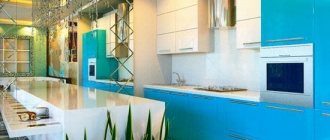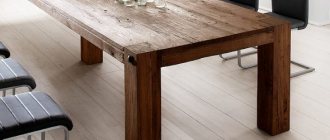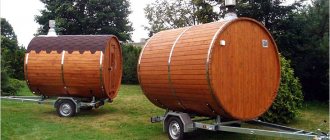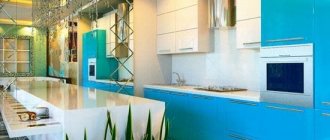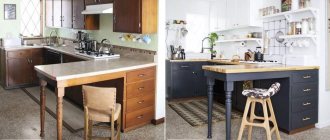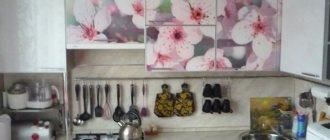In recent years, the construction market has been replenished with a new material - MDF panels. Due to their specific properties, these boards began to be used both in the furniture industry and as a finishing material. However, the environmental safety of these products raises many questions among consumers.
Concerns about the release of hazardous compounds by the material worry people and give rise to various speculations.
The only way out is to understand the peculiarities of production and the composition of the slabs, and study the expert opinion.
Harm to human health from MDF furniture and panels
When selecting furniture, each of us asks ourselves what material to choose from. Quite often the choice is between MDF boards and chipboard. If you take the issue of choosing a material seriously, it’s worth figuring out what these abbreviations really mean.
MDF (Medium Density Fiberboard) – the binding element of this material is urea resins transformed with melamine. MDF boards are made using dry pressing of chips at high temperatures.
Furniture made from chipboard or MDF: which is better to choose?
When buying furniture for your home, you often face a difficult task: what is better to choose - laminated chipboard or MDF.
The slabs are very similar in appearance, the products made from them look approximately the same and at first glance there is no obvious difference. Meanwhile, there are very different differences: in terms of placement, durability and safety. And without having an idea about the features of each material, you will not be able to make the best choice. But everything is not as difficult as it seems. In this article we will tell you how laminated chipboard differs from MDF, about the advantages and disadvantages of the finished product. And also, you will learn what should be taken into account without fail.
And for those who don’t have time to understand all the intricacies of furniture production, at the bottom of the page there is a picture hint “Chipboard or MDF: which is better?” It indicates the main differences between furniture made from these materials and the suitable area of the apartment for placement.
So:
Composition of panels and slabs
The main toxicant that MDF panels are made of are resins; they replaced phenol, which was even the most toxic.
- Wood shavings (sawdust).
- Varnish.
- Veneer (perhaps without it).
- Carbide group resins.
MDF is harmful to human health for a number of reasons. On the terrain of the Russian Federation (Russian Federation is a state in Eastern Europe and Northern Asia, our Motherland)
Fiberboard products are of fairly low quality, so we will talk specifically about low-quality products.
The composition of Russian MDF contains resins, which, when used in everyday life, emit toxic formaldehyde. This toxin (poison of biological origin)
irritates the eyes, causes dermatological irritation and even threatens the respiratory tract. Because of this, when using MDF boards, the harm cannot be overestimated.
Formaldehyde is a substance in the form of a gas, a toxicant. It has a pungent odor and is widely used in the chemical industry.
Environmental friendliness and impact
Panel manufacturers say that products made from MDF are much safer and more natural than, for example, products made from chipboard. Naturally, such information cannot but amuse, but it’s still worth understanding in more detail so as not to choose between “bad” and “even worse.”
The fact is that in order for MDF boards to be very non-hazardous, they must be used in an unheated place, without exposure to sunlight. Otherwise, the material will absorb condensation, or will release the formaldehyde mentioned above.
Lining from MDF for wall finishing is very risky. As we have already said, condensation collects inside heated rooms; over time, it can have a bad effect on those living in such a house. We will not list the diseases that those living in a room with an MDF wall are at risk of falling ill with.
How to reduce harm from MDF
In order to protect yourself from the harmful effects of products, you should think about gluing the ends of the MDF board. It is from the ends of the panel that the greatest evaporation of harmful substances into the air is released. This maneuver will be able to reduce the release of harmful contents of the material, but you yourself realize that reducing does not mean getting rid of it completely. It is best if the products you use are 100% painted with varnish or paint.
Is chipboard more environmentally friendly than MDF?
Let's say right away that both the 1st and 2nd materials are approximately identically non-ecological. Both MDF boards and chipboards can be the least harmful to human health only under certain criteria, which are very difficult to select and this actually cannot be the case in home conditions.
To breathe easier
Of course, if checks confirm that the furniture is dangerous, it will have to be disposed of. But if the low concentrations of formaldehyde released do not pose a risk to life and health, but the smell is still there, you can try to reduce your exposure to carcinogens on your own. To do this you need:
- Do not clutter the room with furniture. The smaller the room, the less furnishings it needs. You need to limit yourself to only the essentials.
- If possible, allow the new furniture to sit for a couple of weeks in a non-residential area (spare room).
- Ventilate the room more often. This will reduce the concentration of harmful formaldehyde and improve the health of the air.
- Get an air purifier (or washer). Or regularly (the more often the better) carry out wet cleaning.
vote
Article rating
Product composition
The production base for both options is one component: most often it is low-value coniferous or deciduous wood or residues in the form of chips, sawdust and rejected sections of logs of the highest class. But the development of slab production varies significantly:
Both chipboard and MDF are made from waste from the woodworking industry, but using different technologies
- Chipboard. The raw materials undergo preparatory cleaning, after which they are crushed into small elongated chips and dried perfectly. Then the mixture enters a special drum, where formaldehyde resin is applied to it. The essence of the process is that the entire surface of the dry component must be covered with an adhesive. After this, molding and pressing is done.
- MDF. In the base of such a product, the smallest fraction, after previously prepared wood chips, is actually crushed into powder. Lignin and carbide resins are mixed into the purchased material, which are additionally modified with melamine. This development allows us to significantly reduce the level of harmful fumes. Next, the mass is given a shape and sent for hot pressing.
Chipboard and MDF - what's the difference?
Laminated chipboard, or more correctly, of course, would be chipboard, as industrialists call it, but among the people the name without the letter “t” has stuck. It is produced from waste from the wood processing industry - sawdust, by hot pressing using a formaldehyde-based adhesive resin.
The chipboard is laminated with melamine film and cut into parts. Since the material absorbs moisture well and swells, the ends of the facades are sealed with an edge. This technology not only prevents water from getting inside, but also reduces the release of formaldehyde vapor to a safe minimum.
Russian GOST, adopted in 2010, obliges compliance with safety standards and allows the use of only laminated chipboards of emission class E1 and E0.5 in the furniture industry. Moreover, this standard allows us to produce chemically safe children's furniture. You can read more about the current regulations in this article.
Pros and cons of furniture made from chipboard:
- The obvious advantage is the low price of the final product. Even with a modest budget, you can furnish your apartment quite decently.
- The disadvantage is the possibility of moisture getting between the joints of the coating. It is necessary to remove water from problem areas in a timely manner.
- And one more thing - the material is most vulnerable at the places where the fittings are attached. It is not advisable to frequently disassemble and reassemble furniture made from laminated chipboard. With constant screwing in and out of screws, the slab crumbles and the holes increase in diameter.
Furniture made from chipboard from our catalog
The Russian reading of the English abbreviation MDF (Medium Density Fiberboard) translates as “medium density fiberboard” or, simply put, fiberboard. It is made from the same sawdust, but the smallest particles are used for production. The fundamental difference is in the composition of the glue. Natural resins – lignin and paraffin – are used to glue fibers together.
The result is a more dense, durable and moisture-resistant material. Significantly superior to chipboard in terms of environmental friendliness. The plate bends well - you can give the products a curved shape. And the high density of the structure makes it possible to produce beautiful carved and framed facades.
Another difference:
The process of cladding MDF is significantly different from lamination. The finishing layer is applied to already finished facades, which allows you to cover both the front and side parts at the same time. There is no need to seal the ends with edging material.
And one more thing:
Furniture entirely made from MDF is practically never found on sale. The most common combination options are where the body is made of laminated chipboard and the facades are made of MDF.
Health Hazard
The main harm comes from the connecting components. There are ideas that often exaggerate the actual impact of stoves on human health.
An excessive concentration of such substances causes a disorder of the central nervous system, which is expressed by dizziness and loss of appetite. Irritation of the upper respiratory tract, a feeling of nasal congestion and exacerbation of acquired diseases may also occur.
Attention! A huge amount of contradictory information has given rise to the myth that the harm of MDF and chipboard is enormous, therefore one should completely abandon their use for interior work or furniture production. In fact, the danger posed by the materials is somewhat exaggerated.
Negative health effects of cheap furniture
Low-quality furniture containing large amounts of formaldehyde or phenol can cause various health problems. Here are just the main negative impacts:
- Airways. There is difficulty breathing and swelling of the throat. It becomes difficult for a person, especially someone suffering from asthma or allergies, to breathe. When you are in a room with a lot of cheap furniture, you experience a constant cough, runny nose, and suffocation.
- Mucous. Here the negative effects range from relatively mild inflammation and irritation to irreversible deterioration of vision. For example, children may develop myopia.
- Nervous system. Formaldehyde and phenol are the causes of insomnia, chronic fatigue, loss of performance, and depressed mood.
- Reproductive functions. Low-quality cheap furniture can cause infertility.
- Oncology. It has been proven that increased concentrations of formaldehyde provoke the growth of cancer cells and can cause leukemia.
These are the serious health problems caused by cheap, low-quality furniture made from dubious raw materials. Therefore, when you decide to save a little, think about how much money will ultimately be spent on treatment.
Aspects affecting environmental performance
To find out how toxic fumes are, you need to consider the following reasons:
- All wood fiber and particle board materials emit formaldehyde to varying degrees. For chipboard, this figure is significantly higher, since a larger amount of binding resins is used for its production. But, speaking about the harmfulness of such products, one must take into account that formaldehyde (an aqueous solution of the substance) is included in almost all cosmetics and household products.
Formaldehyde is the most dangerous compound in furniture and finishing boards
- A terrible concentration of a poisonous compound in the air can appear if the room is not ventilated. Also, to reduce the effect, simple indoor plants are used, which amazingly purify the air from almost all contaminants.
- There are regulatory characteristics of environmental friendliness. For production facilities located in the Russian Federation, GOST standards apply: 27678 for slabs and 30255 for interior items. According to them, the material is divided into emission classes: E1 - containing 10 mg of formaldehyde per 100 g of dry matter and E2 - with indicators from 10 to 30 mg per 100 g. Similar characteristics are found in GOST 4598-86 and TU (technical criteria) 5536 -026-00273643-98 in the manufacture of MDF. Natural untreated pine boards belong to emission class E1.
- European standards are actually similar to GOSTs, which are in force in the Russian Federation, but there is a division into low classes. The emission indicator E0 is becoming increasingly popular. Almost everyone incorrectly believes that a panel produced according to these standards will not emit unsafe substances, but this indicator only states that the concentration will be reduced to a value of at least 2.5 mg per 100 g of dry matter.
When purchasing products made from chipboard or MDF, you should make sure that you have a wet-stamped certificateAlmost all the characteristics in the regulations seem very strict, but they indicate the permitted content of the component in the panel itself. When determining the maximum concentration in a room, you need to take as a base the area of the room, as well as the dimensions of the areas of the slabs through which evaporation occurs. This is the only way to realize how harmful it is to be indoors.
Signs of quality products
The quality of MDF panels is determined by compliance with production requirements and the properties of the raw materials used. When purchasing products, you should check with the seller for a sanitary and hygienic certificate or certificate for the product. Domestic factories often violate the production standards for such slabs due to savings on materials. The most trusted and popular are slabs produced in European countries in accordance with unified standards.
You can significantly reduce the amount of formaldehyde released into the environment by gluing laminated strips on the cut line of the sheet. Panels coated with polymer substances can not only decorate the room, but also reduce the intensity of the release of formaldehyde compounds into the environment.
Due to their unique properties, MDF panels deserve attention from consumers. Their demand is due to the unique characteristics of the material: lightness, good performance and the ability to purchase sheets with specified properties (fire-resistant, moisture-resistant). The ability to produce shaped products and relief facades using MDF expands the scope of its application and contributes to the widespread distribution of boards of this type.
How to choose non-hazardous material
To purchase non-hazardous finishing products or furniture, you need to consider the following tips:
- Release occurs only through uncovered or untreated surface areas. Most often these are the ends of panels and parts of interior items made from chipboard. In the “economy” sector chests of drawers, the invisible edges of the drawers remain open. The area of these parts is very small to indicate the highest toxicity. But if in doubt, it is better to give preference to the most expensive products or additionally lay the edge on open areas.
The higher the level of lamination of furniture boards, the less dangerous they are.
In general, any low-quality cladding materials can be dangerous.
Does OSB cause harm to health - the whole truth about the environmental friendliness of boards
OSB (OSB in transliteration) or OSB sheets are in demand in rough repair and construction work.
To obtain a non-trivial result, they are occasionally used in fine finishing. What stops people? First of all, rumors that OSB boards are harmful to health.
Let's try to figure out how dangerous they are for humans. Oriented strand boards are a construction and finishing material, 86-90% consisting of large finely planed wood chips up to 25 cm long and chips no more than 4 mm thick.
The remainder of the total mass is thermosetting synthetic resins, special additives and additives. OSB-1 – thin sheets intended for packaging, manufacturing of furniture blanks, temporary structures, etc.
OSB-2 – used in rooms with normal humidity (no more than 60%).
What do salt and chipboard have in common?
What happens if you combine two poisons to form a new substance? Correct: a new substance with unique properties. A colorful proof of this is kitchen salt, ordinary sodium chloride.
Chlorine is a poisonous asphyxiating gas. Pure sodium is flammable, and as a result of its violent reaction with water, a caustic alkali appears. But the combination of these two substances - sodium chloride - plays an important role in human life. So important that people on average consume up to 5 kilograms of salt per year. With all this, no one even thinks about associating it with chlorine or sodium - the characteristics are not the same.
APPLICATION
MDF is successfully used in the production of cabinet, kitchen and office furniture, as well as non-standard furniture and in the production of commercial equipment. MDF is widely used by manufacturers of semi-finished furniture (facades, furniture moldings, countertops.) In construction, it is used as wall panels, ceilings and laminated floors. At a lower cost, in terms of its environmental and quality characteristics, MDF is close to natural wood, which ensures its widespread use.
Danger! Natural wood species!
Let's return to the standards. For the production of furniture for residential premises, it is allowed to use chipboard and MDF of class E1 and E0, and these materials are allowed even for the production of children's furniture. Class E2 is not recommended for the production of household furniture and is not even made in some countries.
What do these standards mean? They indicate how much formaldehyde is contained in the finished board:
From time to time you can come across this format:
- E0 - up to 0.01 mg/m3;
- E1 - up to 0.125 mg/m3;
- E2 - from 0.125 to 1.25 mg/m3.
This is a record of the test results, during which it is determined how much formaldehyde emitted by the stove (or a product made from it) is contained in one cubic meter of air in contact with the product. When they talk about the dangers of chipboard or MDF, they rely specifically on the 2nd format for recording standards, because we do not eat these materials, but breathe their fumes.
And now attention - focus! What is a healthy alternative for fiberboard? Natural wood? But they didn’t guess right: some types of wood contain up to 12 mg of formaldehyde per 100 g of material. And freshly cut oak during the drying process “fonit” 0.75 mg/m3 of formaldehyde. If this wood species is heated to 40 °C, then even dry material will release 0.5 mg/m3.
This is a full emission class E2 - an unaffordable luxury for furniture manufacturers.
Conclusion: Uncoated chipboard, under equal conditions, can “stain” even less than the freshest furniture made from natural wood. Well, how was the trick, was it a success? Then I suggest you enjoy one more.
And there’s nowhere to hide...
The highest single maximum permissible concentration of formaldehyde in the air of populated areas, established by law, is 0.05 mg/m3. At rush hour, thanks to car emissions, it can be exceeded by 1.5-2 times. The average daily maximum air concentration is 0.01 mg/m3, but due to the smog in large towns, this value can be exceeded.
Where to hide from the urban formaldehyde background? In the forest? Is it okay that on a warm sunny day a pine forest (again the ideal of purity) can amuse itself with eight times the maximum permissible concentration? Although, in fairness, it must be emphasized that usually the air there is not so saturated with this substance. Especially after rain, which washes the carcinogen out of the atmosphere, turning it into a nutrient medium for plant roots.
How to protect yourself when choosing furniture
Unfortunately, not everyone can buy environmentally friendly furniture made from natural wood. Even when purchasing a solid wood set for a bedroom or nursery, a living room or hallway often has to be furnished with cheap chipboard furniture. How can we reduce possible harm in this case?
Rules for choosing furniture
Furniture made from chipboard and laminated chipboard can be both harmful to health and environmentally friendly, it all depends on the concentration of formaldehyde. Therefore, when choosing, pay attention to the markings. The safest class is E (0), E (0.5). Marking E (1) is also allowed; such furniture is practically harmless. But class E (2) is unacceptable for housing.
It is very important that the chipboard is covered with a protective layer - lamination, and not only the facades, but also the ends, corners, and edges must be treated. Any open area is a source of formaldehyde evaporation.
When purchasing, be sure to request a receipt. If new furniture has been in the apartment for more than 10 days, and an unpleasant characteristic odor is felt, it is better to return it to the seller and not risk your health. Most likely, it is harmful.
Terms of use
To reduce the negative impact of a harmful toxin, you need to try to weaken the influence of the factor itself. It will not be possible to get rid of formaldehyde contained in cheap furniture, but you can reduce its concentration. The first way to eliminate it is active ventilation. You can artificially create a draft or use a breather or air purifier. The method will reduce evaporation.
In rooms with a lot of cheap chipboard furniture, it is better to use heating devices as little as possible. It is advisable to buy plants that can cleanse the air of toxins: fern, ivy, dracaena.
Sometimes manufacturers recommend wiping cheap chipboard furniture with a wet cloth as often as possible - supposedly this reduces harm. In fact, moisture causes surfaces to swell and release formaldehyde, so countertops and facades must be wiped with damp wipes and then be sure to wipe dry. To remove heavy stains, it is permissible to use a soap solution, but drying after this is also necessary.
Other tips to help you stay healthy:
- Do not use abrasives, compounds containing acetone, or solvents to care for chipboard furniture. Hard sponges can damage the protective layer of the lamination and cause increased release of formaldehyde into the air.
- To protect surfaces from dust, use antistatic compounds.
- Any damage to cheap furniture should be repaired immediately - covered with varnish or at least PVA glue.
What does eco-friendly furniture look like?
High-quality furniture that will never cause health problems - made from natural solid wood, the elements of which are glued together using harmless PVA glue. The upholstery of sofas and armchairs should be made of cotton, linen, or eco-leather. Of course, not everyone can afford ecological furniture made from solid wood, but for children's rooms and bedrooms it is better to try to buy more expensive sets, but made from natural wood. For example, an inexpensive bed made of solid birch or pine, in the production of which no casein glue was used, is suitable for a child.
If it is not possible to update the entire furnishings with ecological furniture, try to reduce the amount of cheap furniture, this will help reduce the concentration of toxins. For the nursery and bedroom, it is very advisable to order interior items made from high-quality materials, at least MDF, but from a reliable Belarusian manufacturer, for example, Pinskdrev.
How to protect yourself from formaldehyde
All of the above has only one goal - to prove that you should not blindly believe propaganda. Animals in the forest do not die or mutate. Even the birds that live in tree hollows. And modern chipboard and MDF are somewhat safer than natural wood.
If this is little consolation, then additional measures can be taken to reduce the concentration of the carcinogen in an apartment with the latest furniture. The most effective of them are:
- constant ventilation;
- maintaining a comfortable temperature (at +20, furniture will emit light twice as weakly as at +25, and the rule also applies to subsequent +5);
- control of relative air humidity (with an increase from 30 to 70%, the intensity of formaldehyde release increases by approximately 40%);
- wet cleaning with painstaking rinsing of the cloth used in a large amount of water;
- indoor flowers, almost all of which very successfully absorb toxins (Ancient Greek toxin (toxikos) - poisonous - poison of biological origin)
from the air.
Phenol
Phenol is a very common aromatic substance. In its pure form, it has the appearance of crystals with a faint smell of gouache - or, to be clear, this gouache smells of phenol. Smoked products also smell of phenol and its derivatives, since smoking practically represents the saturation of the product with aromatic hydrocarbons. It is they who assign the appropriate smell to products and they also have a disastrous effect on the smallest organisms. Unfortunately, not only on them.
Phenol is poisonous. When it comes into contact with the mucous membrane, it causes powerful irritation, and when inhaled, it disrupts the functioning of the nervous system (an animal organ that serves to transmit information important for the body to the brain)
cells. In addition, it simply reacts with various substances that are in our body. The aromatic compounds formed during all this can accumulate and cause various disturbances. There is evidence that at least some of them are carcinogenic, although there is no evidence that phenol itself is carcinogenic to humans.
The great news is that modern chipboard contains no phenol. It is done using urea-formaldehyde resins, which in principle do not contain phenolic compounds. Phenol-formaldehyde resins are now used only for the production of FSF plywood and laminated plywood based on FSF, but plywood of these brands is prohibited from being used indoors.
Lining is an environmentally friendly, durable material for decorating a country house
The design of any beautiful and comfortable house with a harmonious and cozy interior, be it a multi-story brick mansion that allows you to forget about the bustle of the city throughout the year or a small wooden house for the seasonal residence of two or three people, includes dozens, or even hundreds of different construction materials. and finishing materials.
In this article we will talk about the so-called molded products, which include lining, block house, and imitation timber. This product is called so due to the fact that due to the complexity of the geometric profile, molded products cannot be stacked and measured in cubic meters. Therefore, their quantity is determined by measuring in length, in linear meters. This became the determining factor for the common name - molding.
Molded wood products fit perfectly into any interior and are often inseparable structural elements; they are environmentally friendly, and when treated with special compounds, they do not lose their properties and appearance for a long time.
No matter how technologies and methods of wood processing change, there are probably no more universal materials in construction. If, when carrying out interior or exterior finishing work, wood is chosen as a cladding material, you cannot do without lining . Wood is loved not only for its natural, living properties - it is an excellent building material that meets modern requirements and ease of use.
Judge for yourself - lining can be used for both internal and external work. Walls lined with clapboard have a flat, smooth surface. Everyone has long known about the excellent soundproofing properties of wood - it is almost 100% sound reflection. In certain places, a wooden board is practically the only possible material for finishing interior walls. Modern lining production technologies make it possible to radically change the appearance of a building sheathed with wooden boards “like a log” - block house , or “under a beam” - imitation timber .
Economically, covering walls with wood is ultimately more profitable than finishing with many modern materials - after all, there is no need to perform preliminary preparation of the walls. The tree is good for human health. It creates a comfortable indoor atmosphere for a person, retains heat well and maintains constant air humidity. Lining treated with protective compounds will not lose its color even after 10 years. It withstands heat and cold well.
Quite often one can observe that for the external decoration of cottages they use natural stone or materials imitating it, but stone, for all its strength, is a strict and coldish material. And outside the city, in nature, it can even give the house the appearance of an impregnable fortress. In this case, a tree will come to the rescue. A clapboard-clad house will combine the solidity of stone with the warmth and hospitality of wood.
High competition in the molded products market forces some unscrupulous businessmen to act in unacceptable ways. They reduce prices by offering low-quality goods under the guise of quality products. Or they are silent about the delivery price, which turns out to be incredibly high after the purchase. And in the worst case, they combine both of these methods of conducting unfair competition, and the main thing here is not to make a mistake when choosing a supplier, because a mistake when choosing expensive goods can lead to dire consequences in the future. By purchasing products in, you are protected from troubles; we strictly control the quality of the products we sell. Our products are manufactured using the most modern equipment using the latest technologies. In addition, we provide ideal storage conditions for products. All molded products produced are packaged in heat-shrink film to preserve the appearance and moisture content of the board. All products are sorted before packaging. The division into grades is based on natural wood defects and defects that appear during the production process. Thus, there is no technological difference in the production process of different types of lining. All boards undergo the same processing and drying cycle, and separation by grade occurs at the stage of sorting finished materials.
Here you can leave your positive reviews about the work of our company and the online store in particular.
Formaldehyde
Formaldehyde is also not a gift, but it is far from phenol. It is the aldehyde of methanol and formic acid, the most common compound of the class of aldehydes. In ordinary terms, it is a volatile, simply soluble gas with a pungent odor.
Formaldehyde also causes damage to the nervous system and has a local irritant effect; In addition, it is absolutely carcinogenic for animals and humans. Fortunately, it is difficult to inhale any significant amount of formaldehyde under normal conditions due to its volatility. It is very difficult to experience any harm to health due to its residual content in chipboard or MDF. Chipboard with emission class E1 contains no more than 10 mg of formaldehyde per 100 grams of completely dry material, while it constantly evaporates - both during storage in the warehouse, and during transportation, and absolutely always, starting from the moment of pressing. As a result, you can inhale any significant amount of formaldehyde only in an unventilated hangar filled with stacks of chipboard or MDF.
Are MDF panels harmful or not?
Skip to content. You have JavaScript disabled. Some functions may not work. Please enable JavaScript to access all features. Posted January 17 – Dust particles damage the walls of the alveoli, breaking the first immune barrier and opening the way for infections and allergens.
A dust allergy is manifested by symptoms such as runny nose, sneezing, and watery eyes. This is one of the main causes of damage to MDF. It also affects the central nervous system, causing headaches, fatigue and depression, according to several studies.
It may also potentially cause asthma and asthmatic attacks as a nonspecific irritant. Hello everyone, I’m interested in the topic because I’m observing some symptoms on myself and I’ve gotten sick for the second time already, there doesn’t seem to be a fever, snot, weakness, snot, weakness, throat, nose, shaky, eyes irritated at work.
I don’t drink, I don’t smoke, I haven’t used drugs for a long time. I had only one operator. Someone sang to him that copper poisoning makes cigarettes taste sweet. Since then, I began to work only in a respirator. When milling getinaks and textolites, we remove them from the cutting area with a vacuum cleaner. We exhaust the air from the vacuum cleaner directly to the street.
The current is if you cover it with a canopy and blow it from above and suck it from below, or vice versa. On spinning sticks and even crooked ones, there are all sorts of brushes or bells over the treatment area - like a poultice for the naked.
Valera, they will at least suck in fine suspended matter, and that’s good. I'll shovel the rest while wearing a respirator. I put the sleeve to the cutter on the lathe, and the smell has already stopped. The question arose: are the racks in production, or partitions, or the floor, by any chance, made of untreated chipboard or construction plywood?
The shelving is made of non-laminated chipboard and dust, dust, dust. Posted January 18 – What health problems, symptoms, allergies do you observe?
How do you protect yourself from harmful effects? Terrible anamnesis. At the same time, it is suitable for several different ailments. At the same time, there is no need to talk about your production conditions right away. Let them examine it. Preferably comprehensively. Description of the condition of the premises - your premises are complete shit. Dust – aspiration. Ventilation is also important. From OSB it sounds good, they say, but not for long. And from plywood too.
All the voluptuous charges for formaldehyde from furniture are almost nonsense. The exit is negligible, the exit area is small. But when, during the construction of panel boxes that were famously blurted out during the Council of Deputies, some idiot guessed to add formaldehyde-containing resins to the concrete for the slabs. That was it. I miscalculated a little.
You can safely put your centimeters on cough and allergies. The biggest greeting from formaldehyde is cancer. Regarding the rest of the desperate woodworkers who, despite pneumonia, fibrosis, anti-Semitism, opportunism, communism, Buddhism and diarrhea, are in no hurry to do aspiration - I am reporting pleasant details.
Oak dust is great at the bottom of a barrel of cognac. Even more useful than MDF. But if it’s suspended in air, then for some reason doctors don’t recommend it. All comments and moralizing are of an exclusively humorous nature. They do not in any way affect the honor and dignity of the interlocutor of the shabby Cat from the window. Whoever helps people is wasting his time. You cannot become famous for good deeds. Damn it.
Hardener
Some people who are afraid of chipboard and MDF remember the hardener. Previously, citric acid was used as it, but at the moment it is synthetics. And if it’s synthetic, then you can’t expect anything good from it, and chipboard is harmful.
It is necessary to emphasize here that the citric acid that was used earlier was also synthetic - it was not extracted from lemons in any way. Now, instead of acid, they use ammonium chloride (in other words, ammonia) or its mixture with ammonia water.
The amount of hardener in chipboard or MDF is less than 1% of the total mass of the board, and at the same time it is almost completely consumed as a result of curing the resins. The part that is not consumed does not pose any threat. Obviously, drinking saturated ammonia is very harmful, but even Finnish licorice candies contain more ammonium chloride than chipboard. Therefore, you don’t have to worry that your MDF walls will poison you - they are just as harmless as solid wood walls, but at the same time they are much cheaper.
Reasons for the popularity of MDF among furniture manufacturers
MDF is the initial letters of the English expression Medium Density Fiberboard. The technology that is now used in the production of MDF is a refinement and improvement of the technology that was used for the production of fiberboard - fiberboard, made from the smallest fractions of sawdust. In the production of MDF, wood fibers are dried, bonded and formed into a board, which is treated with high pressure and high temperature. Paraffin and lignin are used as fastening elements. Lignin is a natural substance found in every tree. Lignin is obtained from wood by treating it at high temperatures. No harmful resins or phenol are used in the production of MDF. Based on the above, we can safely say that MDF is an environmentally friendly material. Among the main advantages of MDF are: – a sufficient level of softness, thanks to which MDF is very easily amenable to the finest processing, which makes it a favorite material for furniture makers and designers, as it allows the most daring decisions to be realized. Despite the fact that MDF is used in many industries, MDF is mainly used as a furniture material. – despite the fact that MDF has adopted all the advantages of wood, it costs several times less. – the service life of products made from MDF is many times longer than the service life of products made from solid wood.
One of the disadvantages of furniture MDF is the lack of production of this material in our country.
As already mentioned, MDF is used in many areas, but in the furniture industry it is used especially actively and there are many reasons for this. In the production of furniture, mainly solid wood, fiberboard (fibreboard) and chipboard (chipboard) are used. All these materials are practically unsuitable for painting.
Wood is an excellent natural material, it can easily be processed through the finest treatments, but it does not tolerate moisture, it dries out and cracks. Under varnish, cracks in the wood are not noticeable, but under paint, especially light paint, they will immediately catch your eye.
Chipboards (chipboards) are a fairly strong material, excellent for painting, but cannot withstand moisture and cannot be milled. Wood fiber boards (Fiberboard) are a very thin material, they are processed with great difficulty, do not tolerate moisture, and cannot be painted evenly.
Furniture MDF lends itself perfectly to the finest processing, milling and sanding. Furniture MDF can be perfectly painted. Finished products made from MDF furniture do not warp, crack or dry out. MDF, having all the positive qualities of wood, is completely devoid of the disadvantages that are inherent in wood: low density, heterogeneity, the presence of knots, and a tendency to rot. In the production of MDF boards, adhesives containing formaldehyde are not used, therefore furniture made from MDF has received permission for use in children's institutions, hospitals and in those premises that require a high degree of protection from the external environment. Furniture MDF is a universal material, therefore it is widely used for the manufacture of furniture for offices and for the home; doors, countertops, window sills, floors, baseboards, suspended ceilings, packaging, containers, toys for children, school supplies and much, much more are made from it.
Separately, it should be said about the advantages of MDF furniture, which make it an indispensable material for the manufacture of furniture for the kitchen and bathroom. In addition to the fact that MDF is not afraid of moisture and steam, does not crack or change shape, mold and mildew do not form on it, the structure of MDF boards allows you to cut beautiful rounded corners.
Furniture MDF is often covered with a polyvinyl chloride film, the resulting material is called laminated MDF. PVC film will allow MDF boards to reproduce any color and shade, right down to the wood structure. Laminated MDF is slightly more expensive. It is worth noting that furniture facades made from pine or beech oak cost sixty percent more than facades made from laminated MDF. And this despite the fact that constant exposure of wood to moisture renders it unusable, and laminated MDF is not susceptible to its effects, so it will last for quite a long time.
